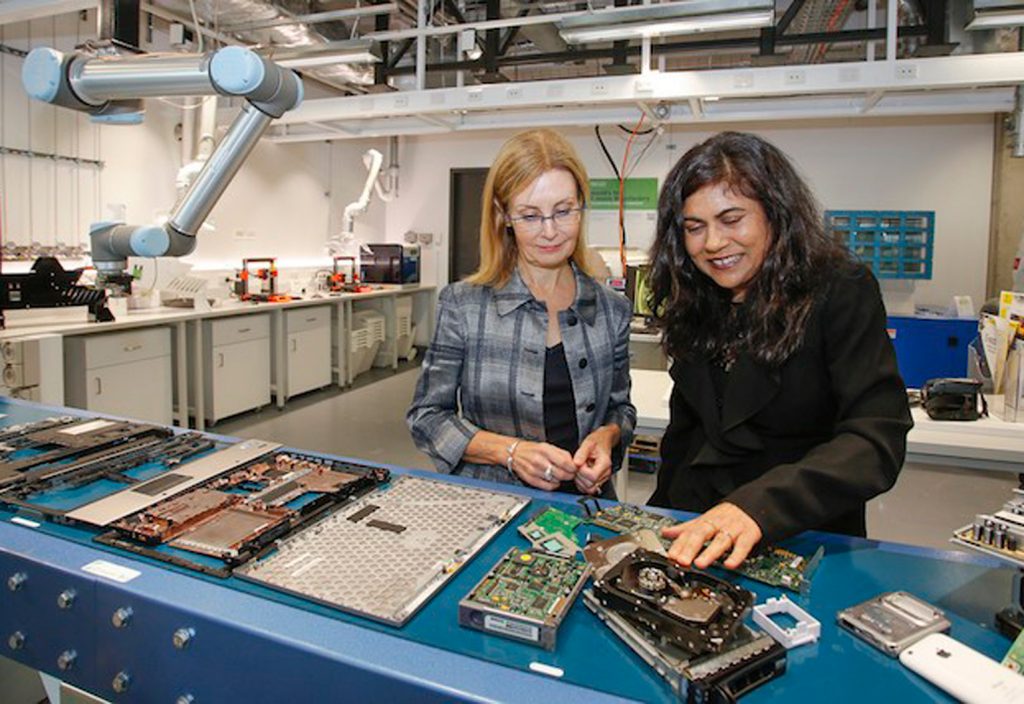New research shows extracting metals from e-waste is more cost effective than mining virgin ores, and Australian-developed microfactories are helping make ‘urban mining’ a viable option.
E-waste is a major global problem, with the United Nations predicting close to 50 million tonnes of electronic tech will be discarded this year as people upgrade to the latest smartphone, laptop or plasma TV, or replace white goods such as washing machines and refrigerators.
Unless things change, most of this waste is destined for landfill. Of the 44.7 tonnes of e-waste generated around the world in 2016, only 20 per cent was delivered to appropriate recycling facilities.
While the sustainability benefits of recycling e-waste have been clear for some time, and technology for extracting and purifying precious metals is available, the economic benefits have been hard to quantify.
But recently published research in the American Chemical Society journal Environmental Science and Technology shows that recycling of metals from obsolete electronic devices makes financial sense.
Crunching the numbers
A team including authors from Tsinghua University in Beijing and Macquarie University in Sydney used data from eight Chinese recycling facilities to calculate the cost of recovering gold and copper from recycled televisions – a process known as ‘urban mining’.
Included were labour collection, staff, energy, transport, materials, equipment and building expenses.
When offset by government subsidies and sale of the extracted metals and recycled components, the research team concluded that recovering ingots of pure copper and gold from used CRT television sets was 13 times cheaper than obtaining the same metals by mining and processing virgin ore.
The paper’s abstract stated if these results were extended to other metals and countries, they could help uncover further economic benefits of reprocessing e-waste through the circular economy, rather than the linear ‘make-use-dispose’ model.
“Our results are confined to the cases of copper and gold extracted and processed from e-waste streams made up of recycled TV sets, but these results indicate a trend and potential if applied across a broader range of e-waste sources and metals extracted,” the paper said.
For example, a tonne of mobile phones (about 6000) contains tens of thousands of dollars worth of precious metals, including: 130 kg of copper, 340 g of gold and 140 g of palladium.
Portable microfactories
Technology developed in Australia could see the real estate area needed for recycling e-waste drop dramatically.
In April, UNSW’s Professor Veena Sahajwalla officially launched the world’s first microfactory. It’s a modular system to convert old phones and computers into materials for reuse that can be installed in an area as small as 50 square metres.
This means e-waste recycling facilities can be conveniently transported to the waste site, cutting down on transport and logistical costs.
Sahajwalla said micro-recycling recognises that complex products like laptops or phones contain a number of recoverable materials.
“It’s not just about the metals, it’s not just about glass or plastics, it’s about every individual material and every component and every part that is so intricately connected that needs to be recognised and reformed into high value outputs,” she said.
NSW Environment Minister Gabrielle Upton said the microfactory was a creative addition to the range of recycling options in the state.
“We can turn toxic waste into high value metal alloys … that can be put back into local communities,” she said.
The microfactories first crush e-waste, then a robot removes useful components to be reheated in a small furnace to remove metal alloys. They can also reprocess plastic components as 3D printer filament.
As well as metal extraction, Sahajwalla is working on a new iteration of microfactory that recycles glass as panels for use in building interiors.
“These are sustainable panels that could be for all types of interiors, whether they’re kitchen bench tops, or they could be pavers or they could be tiles,” Sahajwalla told The Fifth Estate.
Sahajwalla said her vision for microfactories is that they will eventually provide a worldwide solution to the disposal of e-waste in landfills, where it can produce toxins and pollutants.
“Can we actually achieve that dream, that vision? I think we can,” she said.
